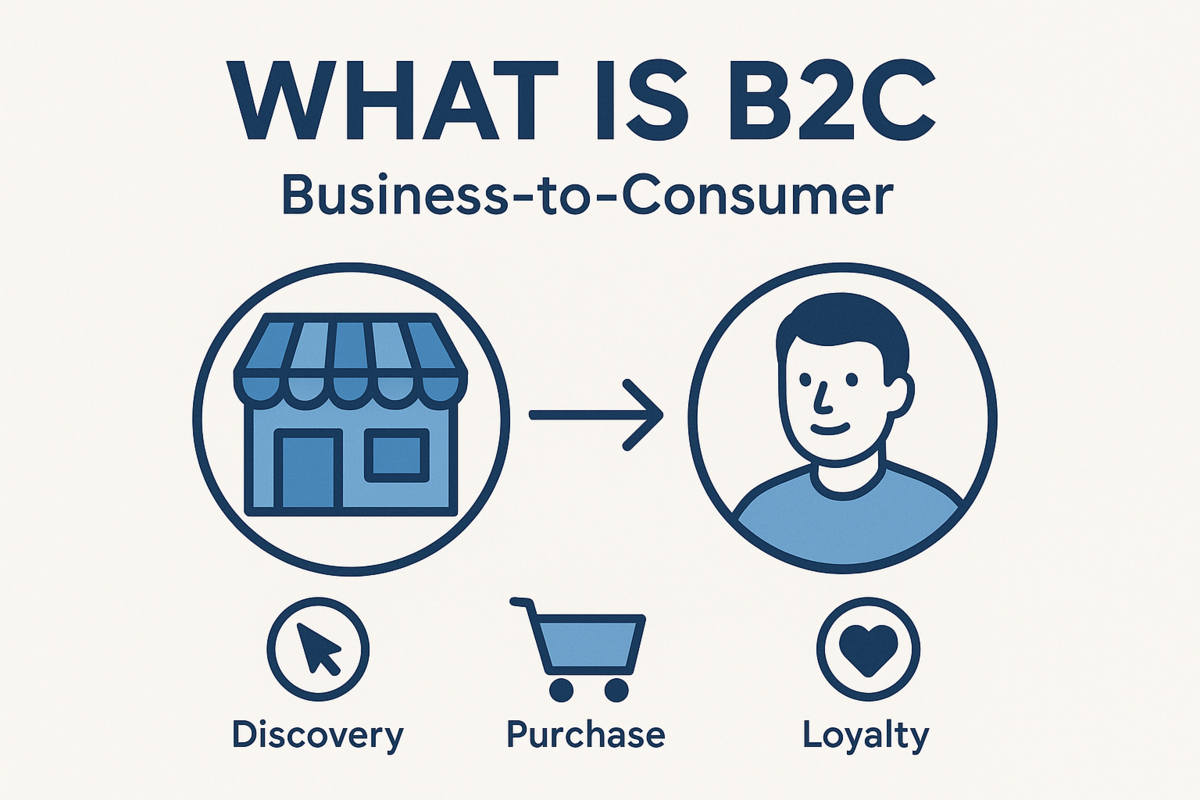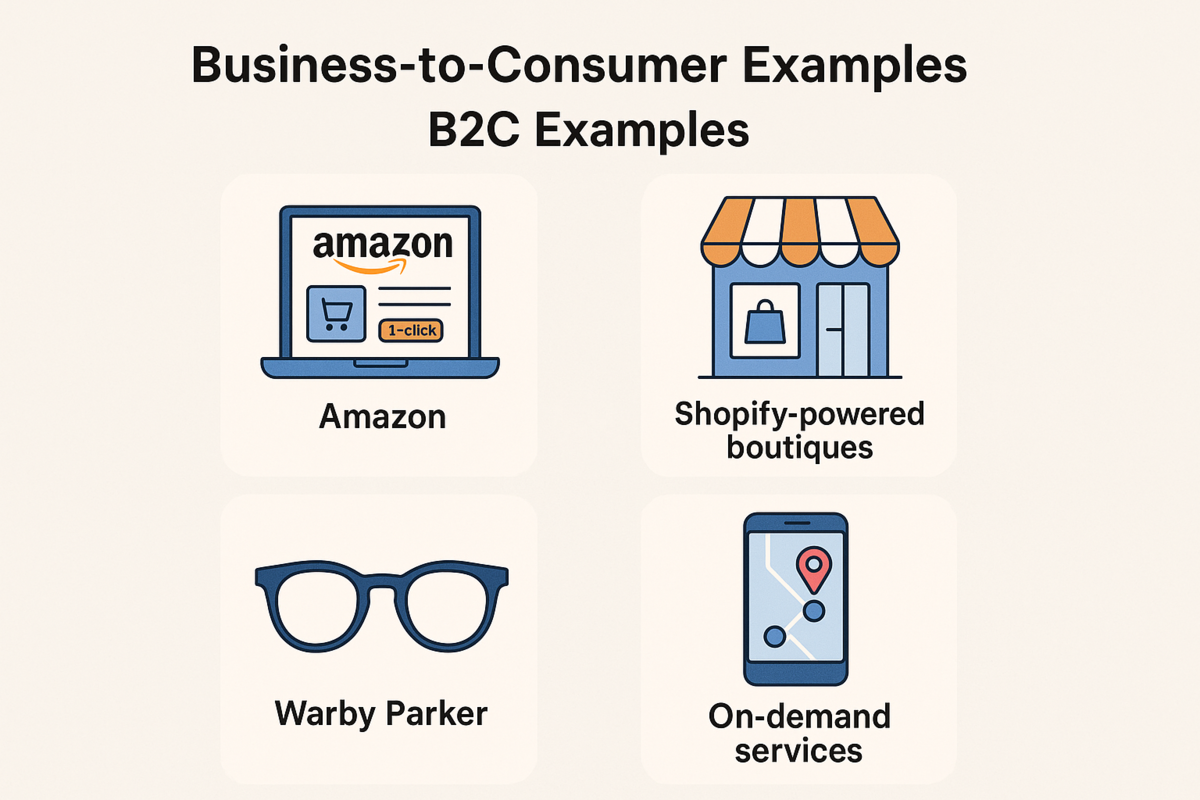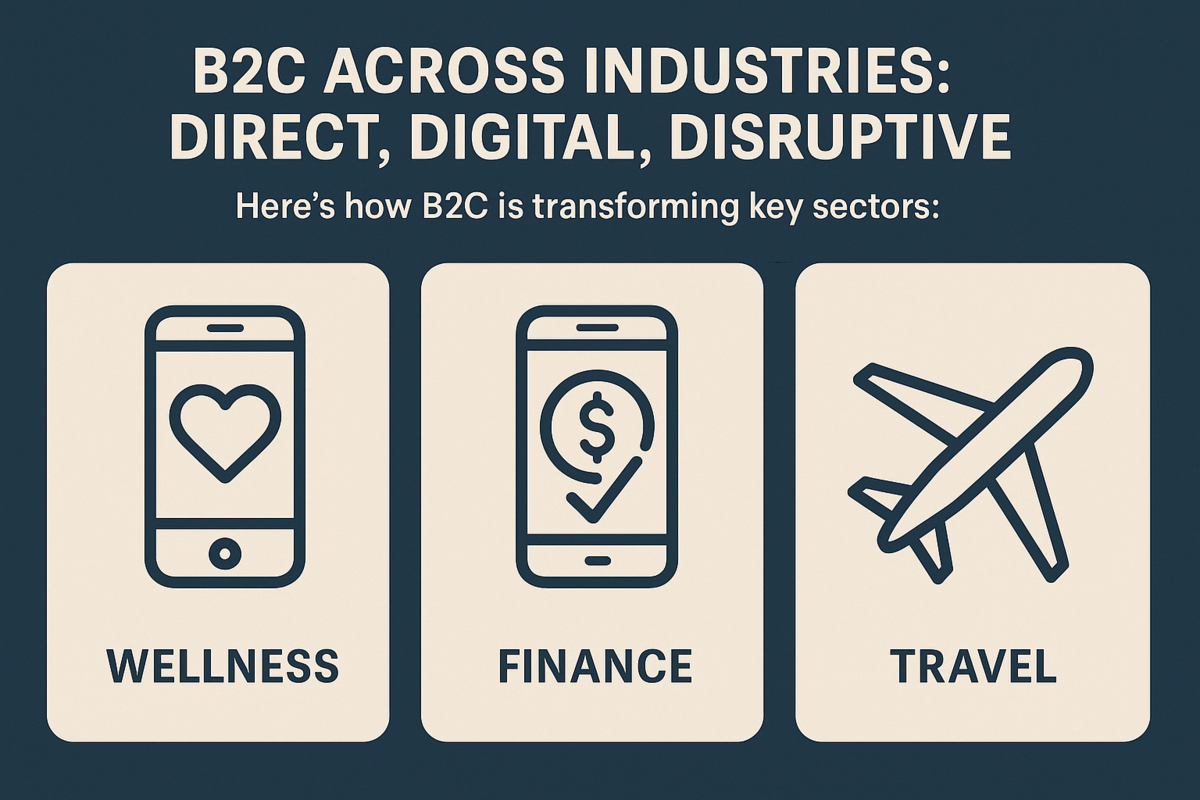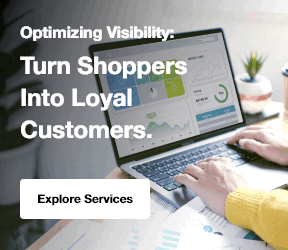In the digital-first era, B2C, or business‑to‑consumer, defines how brands sell directly to end users.
Whether through online stores or in-person interactions, this model focuses on individual buyers rather than other businesses.
The B2C business model is all about accessibility, personalization, and consumer-centric value.
Here, we break down what is B2C, its forms, marketing strategies, real-world examples, and how brands can excel, especially when incorporating services like creative services, SEO eCommerce agency digital marketing services, and web design and mobile development services to drive success.
1. What Is B2C, B2C Meaning, and What Does B2C Mean
At its most foundational level, B2C stands for business-to-consumer, a model in which companies offer products or services directly to individual end-users.
Unlike B2B (business-to-business), where transactions involve negotiations, contracts, and long sales cycles, B2C revolves around quick, emotionally-driven decisions made by everyday consumers.

These interactions happen through various channels, including websites, mobile apps, and physical retail.
But B2C meaning goes beyond the transaction. It includes the full customer lifecycle, from discovery and engagement through purchase, support, and brand loyalty.
A strong business to consumer strategy requires more than just having a product to sell; it’s about creating connections that lead to repeat business and brand advocacy.
To define business-to-consumer (B2C) sales, think of a user-first approach where the experience is designed for accessibility, speed, and satisfaction.
Consumers expect immediate value, transparent pricing, and seamless service, all of which shape the B2C journey.
Whether they’re shopping through B2C ecommerce platforms or engaging with brands on social media, customers crave ease and authenticity in every interaction.
Explore Our B2C Website Design Services!
2. Unpacking the B2C Sales Meaning and Define Business‑to‑Consumer (B2C) Sales
Let’s break down the B2C sales meaning with a real-world lens.
B2C sales typically involve high transaction volume and lower ticket values, relying on volume and frequency rather than complex buyer negotiations.
It’s a landscape where emotion, urgency, convenience, and branding drive conversions. From impulse purchases to planned online subscriptions, consumers decide fast, and expect faster delivery.
To better define business-to-consumer (B2C) sales, consider how platforms like Netflix, Nike, or Spotify operate.
These brands have mastered the art of guiding customers from discovery to purchase in minutes, sometimes seconds.
For example, Amazon's "Buy Now" button eliminates friction, fulfilling the customer’s desire for instant gratification.
This frictionless experience is critical. Unlike B2B, where decision-making is data-heavy and deliberate, B2C sales must capture attention and trust quickly.
Personalization, easy navigation, secure checkout, and responsive customer support all contribute to winning over today’s B2C customers.
Moreover, enterprise SEO solutions play a pivotal role in supporting these transactions, often relying on influencer campaigns, seasonal promotions, and storytelling to build emotional engagement.
These methods help businesses convert browsers into buyers and buyers into loyal brand followers.
3. Exploring the B2C Model and B2C Business Model
The B2C business model has evolved significantly, thanks to technology, consumer expectations, and buying behaviors. Businesses now choose from several formats, each suited to different industries and audience needs.
Here are the most common types of B2C business models:
- E-commerce platforms: These are direct-to-consumer digital storefronts like Shopify or Warby Parker, where users can browse, compare, and purchase with ease. These platforms require intuitive interfaces, fast load times, and compelling product descriptions to boost engagement and conversions. In the Food and Beverage space, direct-to-consumer snack brands and meal delivery services use ecommerce platforms to personalize flavors, manage subscriptions, and deliver farm-to-door convenience.
- Subscription services: In this B2C model, customers sign up for recurring access to products or content—think Netflix, HelloFresh, or Adobe Creative Cloud. Subscription-based B2C businesses must deliver sustained value and convenience to retain customers long-term.
- Online marketplaces: Platforms like Amazon or Etsy operate as digital malls where multiple sellers list products under one umbrella. While this expands reach, it requires a competitive edge in pricing, fulfillment, and product presentation to stand out.
- Mobile-first commerce: With the rise of smartphones, many B2C companies are focusing on mobile-centric strategies, offering apps and responsive websites that enable seamless transactions anytime, anywhere.
What unites all these formats is the need for exceptional user experience. Whether you're using one of the best website builders for small business or working with local search engine optimization company, every touchpoint, from the first click to final checkout—must deliver clarity, speed, and trust.
That’s why investing in digital transformation services is essential for ensuring backend systems evolve alongside user expectations.
From the first click to final checkout, brands must ensure clarity, speed, and reliability.
That’s where design services come into play, helping brands build visually engaging, conversion-optimized interfaces.
Similarly, investing in digital transformation services ensures that backend systems and customer-facing tools evolve with user expectations and industry trends.
Strong B2C companies leverage both to keep pace with changing technology while delivering meaningful experiences that set them apart in the crowded business to consumer market.
Explore Our B2B Marketing Services!
4. Business‑to‑Consumer Examples and B2C Examples
To truly grasp the power of the business-to-consumer model, you need only look at brands that have mastered direct-to-consumer engagement.
A classic B2C example is Amazon, offering a one-stop, hyper-personalized shopping experience. With features like one-click ordering, same-day delivery, and AI-driven recommendations, Amazon has set a new standard in B2C ecommerce.

It connects buyers directly with sellers, eliminating the traditional middle layers of retail and providing instant access to nearly any product imaginable.
Other notable business to consumer examples include:
- Shopify-powered boutiques: These are small to medium-sized merchants leveraging the Shopify platform to run sleek, nimble online storefronts. Whether it’s handmade crafts or sustainable fashion, these sellers operate in a B2C business model that offers flexibility, reach, and control over the customer relationship.
- Warby Parker: Known for disrupting the eyewear industry, Warby Parker sells prescription glasses and sunglasses directly to customers online and in physical locations, often skipping traditional optical retailers. Their try-at-home program and digital vision test exemplify a B2C business focused on convenience and trust.
- On-demand services: From mobile car washes to virtual healthcare consults, business to consumer sales are increasingly tied to immediate, personalized service fulfillment, driven by Mobile Design & development services and cloud-based tech.
These examples of B2C show how a direct connection with the end user creates space for innovation, faster feedback loops, and stronger brand loyalty.
5. Showcasing Business‑to‑Consumer E-commerce Examples
The world of B2C e-commerce is rich with inspiration, particularly among brands that have nailed the art of blending convenience with emotion.
Here are some standout business-to-consumer e-commerce examples:
- Nike: With its SNKRS app and exclusive mobile drops, Nike demonstrates a B2C commerce strategy that blends gamification, limited-time offers, and influencer culture. By creating scarcity and reward-driven ecosystems, Nike deepens consumer engagement and drives high conversion rates.
- Glossier: The beauty brand is a poster child for the business to consumer model in the digital era. Its strategy began on social media, where it cultivated a community that now powers product co-creation, referrals, and repeat purchases. Customers go from Instagram inspiration to checkout in a few clicks, proving that a strong narrative is key in B2C sales.
- Zappos: Known for its "customer first" policy, Zappos revolutionized online shopping by removing anxiety through easy returns, free shipping, and a famously helpful customer support team. It proves that B2C companies can build loyalty not just through products, but through policies that respect time and money.
These B2C e commerce examples underscore the importance of designing with empathy, delivering fast, and ensuring every step of the customer journey is frictionless.
From navigation to post-purchase care, the business to customer experience must feel human, even when entirely digital.
6. Effective Business‑to‑Consumer Marketing Examples
To thrive in the B2C market, you can’t just show up, you need to show up with purpose and personality.
Consumers are overwhelmed with choices, so brands must compete not just on product quality, but on how they communicate and connect.
Here are some powerful business to consumer marketing examples:
- Personalized social media ads: Brands like Spotify and Sephora use user data to tailor messaging across platforms, making ads feel more like recommendations. This increases click-through rates and builds relevance.
- Influencer partnerships: From unboxings to limited-time promo codes, influencers humanize brands. Their endorsement helps translate value into real-world use cases, especially with Gen Z and Millennial audiences.
- SMS and mobile-first email campaigns: Companies now design email and text messages with a mobile-first lens, brief, visually appealing, and action-oriented. Tools like segmentation and A/B testing ensure campaigns feel timely and tailored.
- Loyalty programs: Starbucks, for example, rewards frequency and app engagement with free products and exclusive perks, building emotional and transactional loyalty simultaneously. Even Non-Profits are embracing B2C strategies, offering donor dashboards, personalized giving campaigns, and storytelling to boost engagement and retention.
These examples of B2C marketing don’t operate in isolation, they’re part of integrated strategies powered by Content Marketing Services, Email Marketing Services, and even B2B marketing services when targeting strategic partners or distributors.
Consistency across channels is key. A clever ad that links to a confusing website wastes effort. That’s why successful B2C businesses invest in storytelling and design that’s aligned across every touchpoint.
7. Identifying B2C Companies and Their Meaning
What defines a B2C company? Simply put, it’s a business that sells goods or services directly to individuals for personal use, not for resale or use in another company’s operations.
The B2C company meaning lies in its simplicity: no intermediaries, no bulk sales, just a focus on consumer satisfaction.
These companies include global leaders like Apple and Airbnb, but also thousands of B2C startups and niche players, from pet food subscriptions to personalized skincare.
Unlike B2B organizations, B2C companies often rely on faster marketing cycles, stronger branding, and a more responsive customer experience.
Their ability to adapt to feedback in real time, and change pricing, promotions, or messaging on the fly, gives them an agility that’s essential in consumer-facing markets.
Whether operating in ecommerce B2C, app-based platforms, or physical retail, the hallmark of a strong B2C business is its focus on accessibility, usability, and emotional resonance.
8. Balancing B2C Products and B2C Services
A successful business to consumer model doesn’t just sell, it serves. That’s why b2c products and b2c services often work in tandem to meet evolving consumer expectations.
Examples of B2C products include:
- Physical goods like apparel, gadgets, and cosmetics
- Digital products like eBooks, music, or downloadable course
In the Technology sector, mobile apps, SaaS platforms, and digital tools are fine-tuned for seamless consumer onboarding and long-term retention.
Meanwhile, examples of B2C services include:
- Subscriptions (Netflix, Peloton)
- On-demand platforms (Uber, DoorDash)
- Personalized services (virtual coaching, mental wellness apps)
Both categories share one key requirement: user-friendliness. Whether you're selling something tangible or providing a digital experience, your offer must be easy to access, use, and trust.
Brands that succeed, like Apple or Calm, understand how to wrap products and services into cohesive ecosystems that add real-life value.
The best-performing B2C businesses today design their offerings around the customer’s daily routines, emotions, and unmet needs.
This often involves leveraging search engine optimization services to meet buyers at the point of intent and using insights from account based marketing to tailor outreach to microsegments.
By blending product value with service excellence, businesses elevate their role in the consumer's life, becoming not just sellers, but problem solvers.
9. Optimizing B2C Transactions
Optimizing b2c transactions is at the heart of creating high-conversion experiences. Whether it's purchasing a product online, subscribing to a service, or booking an appointment, the path must be simple, secure, and friction-free.
Key success factors include:
- Seamless checkout flows with minimal form fields and multiple payment options.
- Transparent pricing, free shipping offers, and upfront return policies that reduce purchase hesitation.
- Security signals, like HTTPS encryption and third-party trust badges, assure customers that their data is safe.
In modern ecommerce, speed matters too, buyers want to complete purchases quickly, often with one tap or click. By integrating optimized UX design with backend functionality, B2C ecommerce platforms can drastically improve both user satisfaction and business outcomes.
10. Emerging B2C Trends
The B2C model is rapidly evolving to reflect how consumers live, shop, and engage in real time. Modern B2C businesses are leaning into these trends:
- Subscriptions: Whether it’s coffee deliveries or curated fashion boxes, subscription-based B2C ecommerce locks in loyalty by offering predictable, recurring value.
- Omnichannel journeys: Customers switch between web, apps, stores, and social seamlessly. Smart B2C companies ensure consistent experiences and branding across all channels, supported by tools like digital marketing services.
- AI-driven personalization: Platforms like Netflix and Amazon adapt content and products to user behavior in real time, proving that the future of business to consumer commerce is built on relevance.
- Social commerce: Instagram, TikTok, and Pinterest now serve as storefronts. Consumers see a product, click a link, and buy, within seconds. This shift exemplifies how B2C marketing has become more visual, viral, and impulse-driven.
These trends are pushing even traditional B2C companies to reimagine their digital strategy, integrating data, tech, and storytelling to stay ahead.
11. The Momentum Behind Business‑to‑Consumer Marketing
The momentum in business to consumer marketing isn’t just about being loud, it’s about being meaningful.
Consumers today crave stories, not just sales pitches. The most successful B2C brands understand that authenticity builds trust and that every interaction can strengthen or weaken the brand relationship.
Core tactics include:
- Emotional storytelling across the web and social media.
- User-generated content to build community and validation.
- Conversational marketing, such as chatbots and live interactions.
- Micro-targeting campaigns, enabled by analytics.
This approach thrives when powered by Content Marketing Services, which craft rich brand narratives, and digital marketing services, which distribute that content across the right channels at the right times.
In short, B2C marketing today isn’t about pushing products, it’s about creating movements.
12. B2C Across Industries: Direct, Digital, Disruptive
The business to consumer model is no longer limited to retail or entertainment. Industries once known for complexity or inaccessibility are now reimagining themselves as direct, agile, and consumer-first.

Thanks to Travel and Tourism B2C ecommerce integration, consumers build entire itineraries, flights, hotels, excursions, on a single platform with instant booking.
Here’s how B2C is transforming key sectors:
- Wellness: Brands now offer AI-curated vitamins, therapy sessions via apps, and fitness plans customized in real time, all purchased and managed directly by users.
- Finance: Robo-advisors, peer-to-peer lending, and digital wallets exemplify the move from traditional banking to B2C commerce that’s mobile, fast, and user-controlled. Even complex sectors like Oil, Gas and Renewables are exploring B2C models, offering real-time energy dashboards and smart home integrations that let consumers track usage and optimize consumption.
- Travel: Consumers build entire itineraries, flights, hotels, excursions, on a single platform with instant booking, thanks to seamless B2C ecommerce integration.
These examples highlight how business to customer strategies empower users while disrupting industries that once relied on intermediaries.
The common thread? Simplified access, control, and trust, delivered through smart UX and sharp digital experiences, often created through design services and digital transformation services.
13. Driving Business‑to‑Consumer Sales
Strong business-to-consumer sales aren’t just built on products, they’re driven by execution. Every step of the buyer journey should reinforce confidence, convenience, and emotional connection.
Here’s what powers winning B2C sales strategies:
- Mobile-optimized UX: With over 70% of B2C ecommerce traffic happening on mobile devices, responsive design is a non-negotiable.
- Fast delivery and gratification: Offering same-day or 2-day shipping, immediate access to digital services, or in-app upgrades taps into the instant-need mindset of today’s consumer.
- Clear CTAs and messaging: Whether it’s “Buy Now” or “Try for Free,” effective B2C selling depends on simplicity and urgency.
- Emotionally resonant branding: People buy from brands they feel aligned with, values, aesthetics, and social impact all play a role.
But the engine that powers all of this? Data. Smart B2C businesses use analytics, A/B testing, and search engine optimization services to refine what works and discard what doesn’t and regularly check Google keyword ranking to refine what works and discard what doesn’t.
This ongoing optimization is what turns clicks into conversions and first-time buyers into brand advocates.
Frequently Asked Questions
Here are five targeted FAQs to clarify key points on B2C:
What is B2C and how does it work?
B2C is when companies sell directly to individual consumers. This model works through intuitive online or physical retail experiences, adaptive marketing, and focused customer service.
What is B2C e-commerce?
B2C e-commerce refers to online stores and digital services where individuals purchase directly. Think of Kindle, Netflix, or fast-fashion sites, making products instantly accessible.
How does B2C differ from B2B?
Unlike B2B which revolves around contracts and lengthy decision cycles, B2C emphasizes fast purchases, brand connection, and emotions, typical in direct-to-consumer retail or services.
What is a B2C example?
A good B2C example is Spotify, offering customized music experiences on a subscription basis, built with UX, personalization, and scale in mind.
What makes a B2C business model effective?
A successful B2C business model combines brand storytelling, optimized user journey, customer insights, and agile feedback loops, often borrowing insights from B2B sales funnel examples to nurture prospects efficiently.
Conclusion
So, what is B2C? At its core, it’s more than just a transaction, it’s a dynamic, relationship-driven commerce model where businesses connect directly with consumers through products, services, or digital experiences. It bypasses intermediaries, empowers personalization, and thrives on real-time interaction. From a single click on a mobile app to an emotional moment shared via social media, business‑to‑consumer interactions are crafted to resonate, engage, and retain. But here’s the often-overlooked truth: behind every strong B2C brand is a B2B strategy that supports scalability, market positioning, and data-driven refinement. With Centric B2B marketing services, your organization can bridge the gap between high-volume consumer transactions and high-quality business growth. It means aligning your internal ecosystem with your customer promise, ensuring consistency across platforms, channels, and campaigns.








